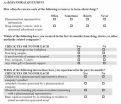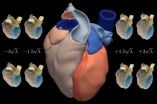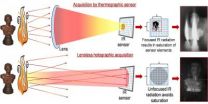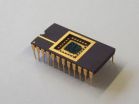(Press-News.org) The researchers conducted a mirror experiment to show that by changing the position of the mirror in a vacuum, virtual particles can be transformed into real photons that can be experimentally observed. In a vacuum, there is energy and noise, the existence of which follows the uncertainty principle in quantum mechanics.
If we act fast enough, we can prevent the particles from recombining – they will then be transformed into real particles that can be detected', says Dr. Sorin Paraoanu from Aalto University.
For the experiment, the researchers used an array of superconducting quantum-interference devices (SQUID). These parts resemble devices used in imaging small magnetic fields in the brain. By changing the magnetic field, the speed of light in the device can be changed. From the standpoint of the electromagnetic field of the vacuum radiation reflecting from this kind of device experiences it as a moving mirror.
By quickly varying the speed of light in the array, we can extract microwave photons out of the vacuum's quantum noise', explains doctoral student Pasi Lähteenmäki from Aalto University.
Future research directions for these kinds of devices include the creation of an artificial event horizon and observation or Hawking radiation emanating from it. The present observation will help cosmologists to get closer to the riddle of the birth of the universe and advance the development of extremely powerful quantum computers.
INFORMATION:
A link to the research article published in the PNAS journal: http://www.pnas.org/content/early/2013/02/11/1212705110.abstract
A link to the news in the Nature journal:
http://www.nature.com/news/a-vacuum-can-yield-flashes-of-light-1.12430
Additional information:
Pasi Lähteenmäki, doctoral student, Aalto University
Light particles illuminate the vacuum
2013-02-26
ELSE PRESS RELEASES FROM THIS DATE:
Target: Cancer
2013-02-26
For scientists to improve cancer treatments with targeted therapeutic drugs, they need to be able to see proteins prevalent in the cancer cells. This has been impossible, until now. Thanks to a new microscopy technique, University of Akron researcher Dr. Adam Smith, assistant professor of chemistry, has observed how clusters of epidermal growth factor receptor (EGFR) — a protein abundant in lung and colon cancers, glioblastoma and others — malfunctions in cancer cells.
"We can directly observe protein clusters, in a living cell membrane, that are invisible to traditional ...
Superbugs may have a soft spot, after all
2013-02-26
The overuse of antibiotics has created strains of bacteria resistant to medication, making the diseases they cause difficult to treat, or even deadly. But now a research team at the University of Rochester has identified a weakness in at least one superbug that scientists may be able to medically exploit.
Biologists Gloria Culver at Rochester and Keith Connolly, now at Harvard University, thought one key to stopping the bacteria may lie with proteins, so they studied the mechanism behind the development of bacterial ribosomes—the cell's protein-manufacturing machine. ...
Gut microbiota plays important role in functional bowel disorders
2013-02-26
(24 February 2013) An estimated 50 per cent of patients consulting a gastroenterologist suffer from functional bowel disorders (FBD), such as dyspepsia or irritable bowel syndrome (IBS). It is characteristic for these conditions that underlying physiological mechanisms are hard to be found. "However, recent research shows that the gut microbiota is a likely candidate for filling some of the gaps in the causal chain leading to FBD," says Professor Fernando Azpiroz, Chairman of the Gut Microbiota & Health Section of the European Society of Neurogastroenterology & Motility ...
Fecal microbiota transplantation cures gastrointestinal diseases
2013-02-26
(26 February 2013) Clostridium difficile infections have developed into a virtual pandemic over the past two decades. The outcome of standard antibiotic treatment is unsatisfactory: the recurrence rates are high with every relapse increasing the risk of further follow-ups. Faecal microbiota transplantation offers a rapidly acting and highly effective alternative in treating recurrent Clostridium difficile infections (RCDI), as Professor Lawrence J. Brandt (Montefiore Medical Center, New York, USA) points out. According to him, more than 90 per cent of the patients are being ...
Survey shows medical students have frequent interactions with pharmaceutical companies
2013-02-26
Boston – A first-of-its kind national survey of medical students and residents finds that despite recent efforts by medical schools and academic medical centers to restrict access of pharmaceutical sales representatives to medical trainees, medical students and residents still commonly receive meals, gifts, and industry-sponsored educational materials. The study was completed by a team of researchers led by fourth-year Harvard Medical School student Kirsten Austad and Aaron Kesselheim, M.D., J.D., M.P.H., an internist and health policy researcher in the Division of Pharmacoepidemiology ...
An atlas of the human heart is drawn using statistics
2013-02-26
Researchers at Pompeu Fabra University (Spain) have created a high resolution atlas of the heart with 3D images taken from 138 people. The study demonstrates that an average image of an organ along with its variations can be obtained for the purposes of comparing individual cases and differentiating healthy forms from pathologies.
"This atlas is a statistical description of how the heart and its components – such as the ventricles and the atrium – look," as explained to SINC by Corné Hoogendoorn, researcher at the CISTIB centre of the Pompeu Fabra University.
Scientists ...
Infrared digital holography allows firefighters to see through flames, image moving people
2013-02-26
Firefighters put their lives on the line in some of the most dangerous conditions on Earth. One of their greatest challenges, however, is seeing through thick veils of smoke and walls of flame to find people in need of rescue. A team of Italian researchers has developed a new imaging technique that uses infrared (IR) digital holography to peer through chaotic conflagrations and capture potentially lifesaving and otherwise hidden details. The team describes its breakthrough results and their applications in a paper published today in the Optical Society's (OSA) open-access ...
Sweet news for stem cell's 'Holy Grail'
2013-02-26
Scientists have used sugar-coated scaffolding to move a step closer to the routine use of stem cells in the clinic and unlock their huge potential to cure diseases from Alzheimer's to diabetes.
Stem cells have the unique ability to turn into any type of human cell, opening up all sorts of therapeutic possibilities for some of the world's incurable diseases and conditions.
The problem facing scientists is how to encourage stem cells to turn into the particular type of cell required to treat a specific disease.
But researchers at the University of Manchester's School ...
A picture of health in schools
2013-02-26
Feeling comfortable and confident in sport, health, or PE can be very difficult for some young people who can be seen as a 'risk' of becoming obese. Young people from ethnic minorities, especially girls, are more likely to be physically inactive and unhealthy.
This perception needs to be addressed and challenged in school physical education (PE) according to research funded by the Economic and Social Research Council (ESRC), which shows how school provision could make use of visual approaches in developing young people's critical learning about the body.
When Dr Laura ...
Blueprint for an artificial brain
2013-02-26
This press release is available in German.
Scientists have long been dreaming about building a computer that would work like a brain. This is because a brain is far more energy-saving than a computer, it can learn by itself, and it doesn't need any programming. Privatdozent [senior lecturer] Dr. Andy Thomas from Bielefeld University's Faculty of Physics is experimenting with memristors – electronic microcomponents that imitate natural nerves. Thomas and his colleagues proved that they could do this a year ago. They constructed a memristor that is capable of learning. ...




